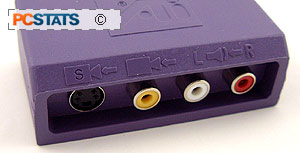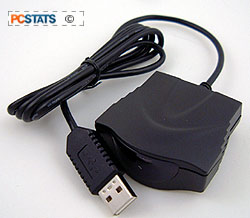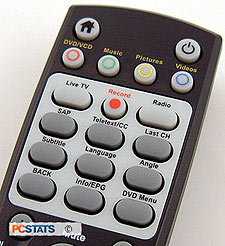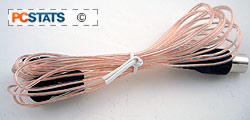 Powercolor ship the Theatre 550 Pro with a good selection of
software and accessories.
Powercolor ship the Theatre 550 Pro with a good selection of
software and accessories.
Included in the box is a
Cyberlink computer remote control (with AAA batteries) along with
a USB infrared receiver for it, an S-video/composite/audio breakout box, a flexible wire antenna and batteries for
the remote control.
Software includes ATI drivers and their multimedia studio, Cyberlink's
PowerCinema multimedia software (which can also be used to take advantage of the
Theatre 550 chip's features) and full versions of Cyberlink's PowerDirector SE+,
MediaShow SE, PowerDVD, PowerProducer DVD and Power2Go applications. These
last are all bundled on a single DVD, so a DVD drive will be necessary to fully
use this product.

The card itself
is compact and quite attractive, with a purple PCB and gold hardware. The
ATI logo is liberally printed all over the Theatre 550 Pro, making its
reference model origins obvious.
 The metal shield covering the
tuning hardware is extremely small for a PCI TV-tuner card, and contributes to
making it much lighter than any TV-tuner we've seen in recent memory. The
Theatre 550 Pro chip requires no cooling, nor does the Samsung memory chip
installed next to it.
The metal shield covering the
tuning hardware is extremely small for a PCI TV-tuner card, and contributes to
making it much lighter than any TV-tuner we've seen in recent memory. The
Theatre 550 Pro chip requires no cooling, nor does the Samsung memory chip
installed next to it.
A pair of coaxial inputs jut out of the card,
one for CATV, the other functioning as an antennae/FM receiver input. A third
connector links to the breakout box, for importing S-video and composite signals, as
well as stereo sound.
pair of coaxial inputs jut out of the card,
one for CATV, the other functioning as an antennae/FM receiver input. A third
connector links to the breakout box, for importing S-video and composite signals, as
well as stereo sound.
The Cyberlink branded remote control is furnished in basic black,
but is quite attractive and easy to hold. Sadly it uses too-soft rubber
buttons which give it an imprecise feel common to many
low-end remotes. It's powered by a pair of AAA batteries, two of which
are included with the Powercolor Theatre 550 Pro package.
It should be noted that this is specifically a
computer remote, and it will not function with your other
A/V equipment, as it contains no programming abilities. Its functions are enabled by
the drivers included with the Cyberlink PowerCinema 3 software.
This
remote features just about every button imaginable, and we will go more in-depth
on some of its functions later in this review.

Installing the card itself was as easy as any other PCI device. The
drivers were also painless, requiring but a single reboot. The card
identified itself as an 'ATI unified AVstream driver' in device manager.
